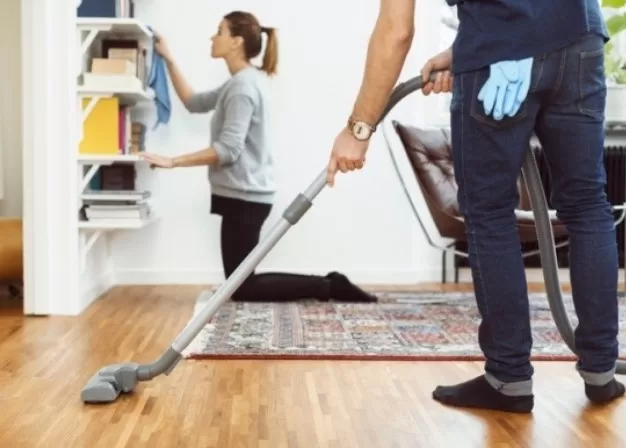The Dirtiest Places in Your House: A Guide to Cleaning Them. Cleaning your home is a task that often focuses on visible dirt and messes. However, there are hidden spots in your house that can harbor bacteria and affect the health of your family.
While the bathroom may seem like the dirtiest room, it’s actually the kitchen that tops the list, according to a study by the National Sanitation Foundation International (NSF).
To ensure a clean and healthy home, it’s essential to pay attention to these hidden areas. Let’s explore each room and discover the hidden dirt and bacteria lurking within, along with effective cleaning and sanitizing methods to eliminate them. From the kitchen to the bathroom, Living Areas to bedrooms, we’ll guide you on how to tackle these commonly overlooked spots and create a healthier living environment for you and your loved ones.
Kitchen

Unveiling the hidden dirt and bacteria in your kitchen is crucial, as it tends to be one of the busiest and dirtiest rooms in the house.
With factors like heat, moisture, and food readily available, it becomes an ideal breeding ground for bacteria. Additionally, the introduction of raw meats, unwashed produce, and germs from personal belongings further contributes to the proliferation of harmful bacteria such as E.
Coli.
The key areas of concern in the kitchen include sinks, countertops, cabinet pulls, refrigerators, small appliances, and kitchen tools.
To effectively clean these areas, it is recommended to keep disinfecting wipes within reach for wiping down sinks and countertops after each use. Cutting boards should be thoroughly washed with hot Soapy Water, rinsed well, and dried with a hand towel after every use.
Small appliances and kitchen tools, such as blenders and measuring cups, should be washed in hot soapy water, rinsed thoroughly with hot water, and dried meticulously to ensure proper cleanliness.
Bathroom

It’s unfortunate that bacteria tends to linger in the bathroom even after each use.
To effectively clean and control the presence of coliform bacteria, it’s important to pay special attention to frequently touched surfaces such as light switches, door knobs, and faucet handles. Keeping disposable disinfecting wipes on hand for daily cleaning can be a convenient solution.
For bathroom linens, it is recommended to wash bath towels and mats in hot water at least once a week and ensure they are thoroughly dried.
Hand towels should be changed several times throughout the week to maintain cleanliness.
Daily wiping of bathroom sinks with disinfecting wipes is essential, and toothbrush holders and cups should be cleaned on a weekly basis.
While cleaning the visibly dirty areas like bathtubs, shower doors, and toilets, it’s also beneficial to take the time to wipe down flat surfaces such as walls near toilets with disinfectant products to ensure overall cleanliness.
Living Areas

Whether it’s the living room, media room, or game room, any space where the family gathers can harbor hidden dirt and bacteria.
Consider how frequently various items like remote controls, game controllers, keyboards, tablets, earbuds, headphones, and cell phones are touched by different individuals. Are their hands always clean?.
To maintain cleanliness, it is important to wipe down all keypads and controllers daily with a disinfectant wipe that is safe for use on electronics.
If someone in the household has a cold or virus, these items should be cleaned after every use. Additionally, don’t forget to clean switches on lamps, switch plates, and doorknobs.
Upholstered furniture can also serve as a breeding ground for bacteria and allergens.
The fabric is exposed to sneezes, unwashed hands, pet dander, hair, and soil from feet and shoes. To address this, it is recommended to vacuum upholstered surfaces at least once a week using a hand-held vacuum or the upholstery attachment of a larger machine.
Pay attention to cleaning underneath and between cushions where food debris and pet hair may accumulate. To freshen and disinfect, use a scented or unscented disinfecting spray.
If someone in the household has a virus or skin rashes, it can be beneficial to cover upholstered surfaces with sheets or washable covers that can be changed and washed frequently to ensure proper disinfection.
Bedroom
Your serene and cozy bedroom, which serves as a personal oasis, can unknowingly harbor fungus, bacteria, and a multitude of mites and insects.
Surprisingly, most of these potential dangers reside right in your bed.
Considering that beds are used for various activities such as sleeping, intimate moments, socializing, eating, and working, it’s essential to address the cleanliness of the sheets, blankets, quilts, and bedspreads.
If these items are not washed regularly, they can accumulate dirt that can lead to various issues:.
Skin irritation, eczema, and acne breakouts.
Fungal and bacterial infections like athlete’s foot and MRSA. Allergies and respiratory problems.
To prevent these problems, it is crucial to change bed linens at least once a week and ensure they are properly washed. Surprising studies have shown that after just one week, bed sheets can harbor more bacteria than a doorknob in a bathroom.
If you’ve ever encountered “clean sheets” from the linen closet that have a stale odor, it’s likely because they still contain body oil and soil within the fabric fibers.
Furthermore, pillows, mattresses, and box springs should be protected with removable, washable, and allergy-proof covers.
These covers help prevent infestations from dust mites, which thrive on the skin cells we shed during sleep.
The Overlooked Culprits: Hidden Dirt and Bacteria in Your Home

Let’s shine a spotlight on the often overlooked areas in your home that harbor dirt and bacteria.
By paying attention to these spots and giving them proper cleaning, you can ensure a healthier living environment for you and your family.
Pet Toys and Feeding Bowls: Don’t forget to regularly clean your pet’s toys and feeding bowls.
Wash them daily with hot soapy water or in the dishwasher to prevent the growth of harmful bacteria.
Keys, Purses, and Wallets: The items you handle every day can accumulate germs and bacteria.
Take the time to clean your key fobs, purses, and wallets. Purses, in particular, can be germ hotspots.
Keep them off the ground and clean them regularly, both inside and out.
Backpacks and Gym Bags: Whether you use them for school, work, or the gym, backpacks and gym bags need regular cleaning and disinfecting.
Over time, they can become breeding grounds for bacteria. Give them a thorough cleaning to keep them fresh and hygienic.
By addressing these overlooked areas, you can maintain a cleaner and healthier home environment.
*The information is for reference only.